One-third of Metro parking customers drive from less than three miles to their station. But Metro’s importance can also be seen far across the greater Washington region, in this new visualization of parking customer’s origins.
Most Metrorail parking facilities primarily serve the neighborhoods immediately surrounding the station: 64%55% of parking customers come from less than five miles away, and 47%35% come from less than three miles away. However, some riders come from much farther away, particularly to end-of-line stations near major highways, such as Greenbelt, New Carrollton, and Vienna.
With approximately 60,000 parking spaces, Metro is one of the region’s largest parking operators. Our 2012 Metrorail Passenger Survey provides good insight into the travel patterns of rail customers, including those who drove and parked at any of Metro’s 35 stations offering daily parking. These parking customers represent around 15% of all rail trips on a typical weekday.
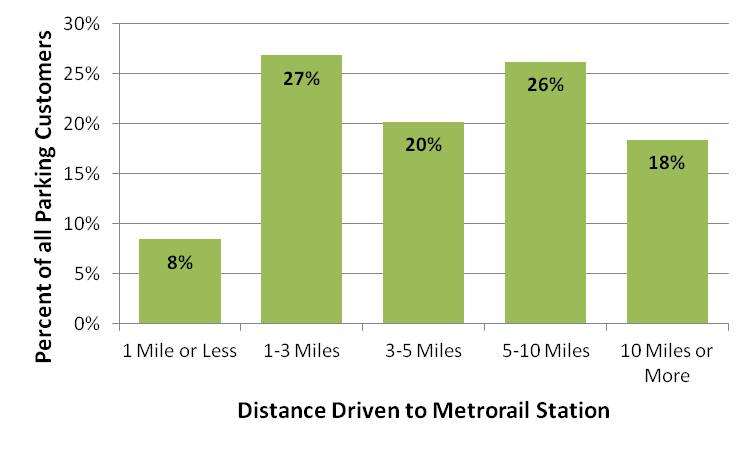
Read more…
Improving and expanding capacity at high ridership stations will ensure safe and efficient operations and facilitate passenger movements from street-level to platform as well as transfers between lines. The proposed stations, most of which are in the system’s core, already experience crowding or would reach capacity by 2025. Proposed improvements vary from adding escalators and stairs to building pedestrian passageways connecting platforms within a station and between stations.
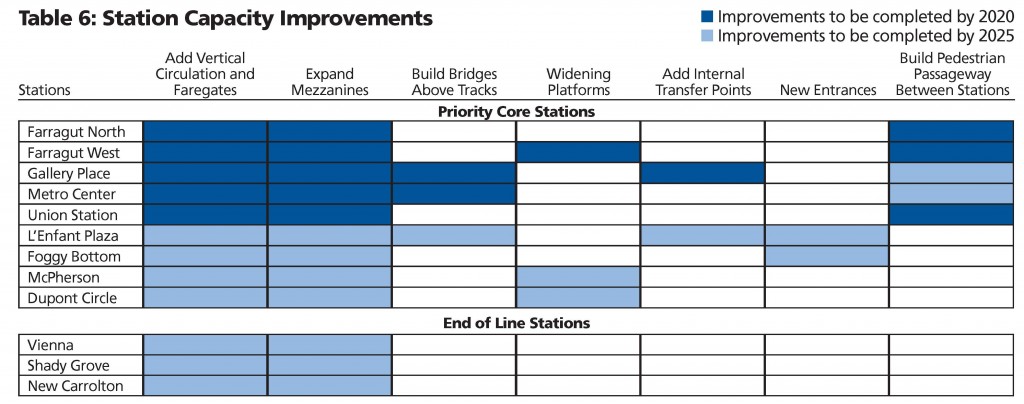
New Metrobus schedules and service improvements take effect Sunday, June 30. More trips and schedule adjustments will reduce crowding and improve reliability.
Pick up a copy of the Metrobus Service Changes brochure, grab a new timetable on-board your bus, or look it up online!
DISTRICT OF COLUMBIA
More trips on the following lines:
- Route 32 Pennsylvania Avenue – weekday mornings
- Route 63 Takoma – Petworth – weekday mornings and afternoons
- Route K2 Takoma – Fort Totten – school days
- Route W4 Deanwood – Alabama Avenue – weekday evenings and weekends
Schedule adjustments:
- Routes 42,43 Mount Pleasant – every day
- Route 63 Takoma – Petworth – weekdays
- Route 94 Stanton Road – weekdays
- Routes 96, 97 East Capitol Street – Cardozo – every day
- Route D5 MacArthur Blvd. – Georgetown – weekdays
- Routes U5,U6 Mayfair – Marshall Heights – every day
- Route W4 Deanwood – Alabama Avenue – weekends
MARYLAND
Schedule adjustments :
- Routes C2,C4 Greenbelt – Twinbrook – weekends
- Route P12 Eastover – Addison Road – weekends
- Routes B21, B22 Bowie State University and Route C28 Pointer Ridge
- Route 89M Laurel and Routes G12, G14 Greenbelt – New Carrollton
- K6 New Hampshire Avenue and K9 New Hampshire Avenue Limited during the weekday PM peak period
The following lines will have earlier weekday service:
- Route F13 Cheverly – Washington Business Park
- Route R1 Riggs Road
The following line will have later service:
- Route C27 Central Avenue from Six Flags Park.
VIRGINIA
- Service to Landmark Mall will be discontinued and new service to Braddock Road and Hampton Drive will be added on Routes 7A,E,F,Y Lincolnia – North Fairlington.
- Service on Route 8W will be modified and service on 8X will be eliminated and replaced with additional 8W trips on Routes 8S,W,X,Z Foxchase – Seminary Valley.
- Later weekday evening service to Culmore on MetroExtra Route 16X Columbia Pike – Federal Triangle.
- MetroExtra designated stops will be added at Columbia Pike and Oakland Street to serve Routes 16X and 16Y.
For more information or assistance, call Metro Customer Information at 202-637-7000 [TTY 202-638-3780] or look for your new timetable online.
Momentum requires Metro to reclaim its leadership role and to ensure that the region’s transit network meets the region’s needs. Metro’s Compact charges it with putting forth plans and mobility projects that enhance regional mobility and to be the champion for the regional rider. This means moving beyond the role of “convener” and mere “coordinator” and embracing the roles of “leader”, “collaborator”, and “co—author”.
Living up to this charge means leveraging the relationships with sister agencies Metro has already built by collaborating with partners from concept to execution. Metro will bring its partners in early to co-author mobility innovations, engage in joint problem-solving, and collaborate on bringing these projects online and into operation. As the lead transit planner, Metro will literally draw the region’s transit map and advocate for its implementation.
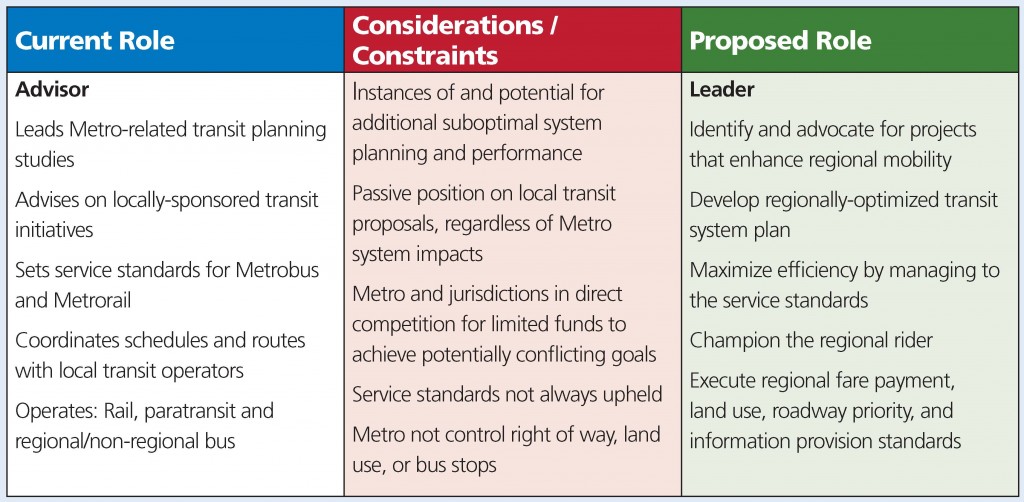
Thanks to its funding partners, Metro is now 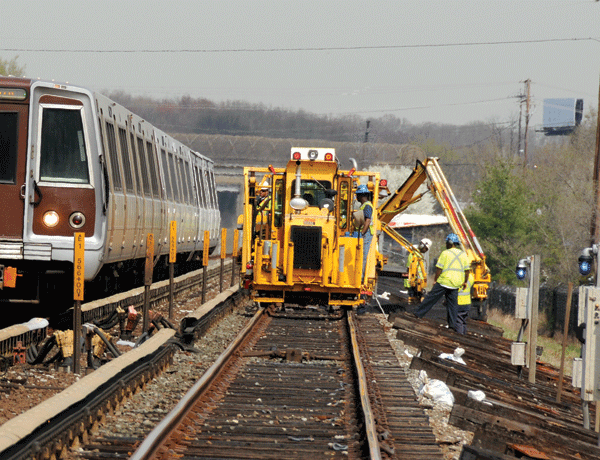 engaged in the largest capital improvement program since its original construction. Two years ago, MetroForward was launched – an aggressive, $5 billion, six-year investment program to rebuild the system. MetroForward is investing in what Metro’s customers value most: safety, reliability, and good customer service. With continued investment, it is projected that Metro will continue to make progress on the intensive MetroForward “catch up” phase in the years ahead. MetroForward has already delivered:
engaged in the largest capital improvement program since its original construction. Two years ago, MetroForward was launched – an aggressive, $5 billion, six-year investment program to rebuild the system. MetroForward is investing in what Metro’s customers value most: safety, reliability, and good customer service. With continued investment, it is projected that Metro will continue to make progress on the intensive MetroForward “catch up” phase in the years ahead. MetroForward has already delivered:
- An aggressive escalator rehabilitation program;
- Continued improved elevator availability;
- Station repairs at Judiciary Square, Shady Grove, Rockville, White Flint, Twinbrook and Union station;
- 461 new MetroAccess vehicles in service;
- Over 200 new replacement or rehabilitated buses in service;
- Electrical upgrades to accommodate additional eight-car trains on some lines; and
- Replacement of over 14.7 miles of rail; 36 No. 8 guarded switches; 16,000 ties; 11,731 cross ties; 62,723 linear feet of running rail; 20,745 fasteners; 8,849 insulators; and 9,829 linear feet of grout pads.
Read more…
Metro is critical to the 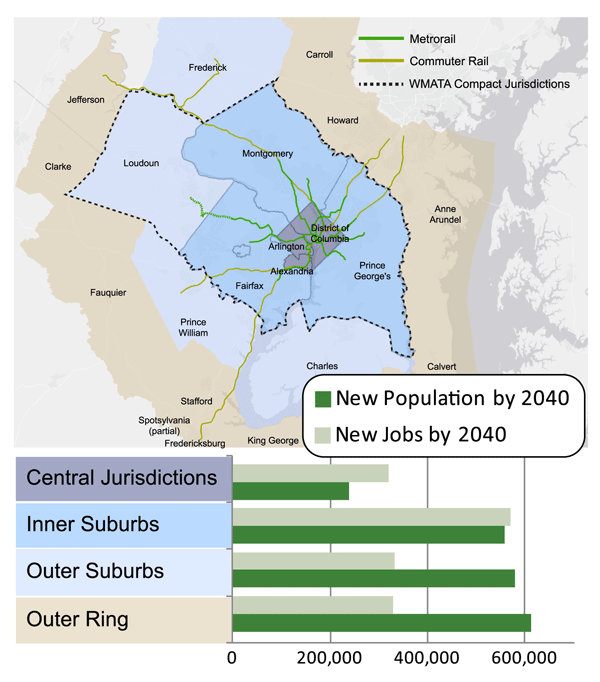 prosperity of the region and has a positive effect on business activity. Within one half-mile of rail stations and bus stops there are two million jobs, which account for 54 percent of all jobs in the region. The figure to the right shows how future employment will be focused in the Metrorail service areas of the central jurisdictions and the inner suburbs.
prosperity of the region and has a positive effect on business activity. Within one half-mile of rail stations and bus stops there are two million jobs, which account for 54 percent of all jobs in the region. The figure to the right shows how future employment will be focused in the Metrorail service areas of the central jurisdictions and the inner suburbs.
The Washington, D.C. Metropolitan Statistical Area (MSA) added 275,000 households and 295,000 jobs between 2004 and 2010. Of that growth, 6.4 percent of new households and 13.8 percent of new jobs located within one-quarter mile of urban Metro stations and one-half mile of suburban ones. The land area around these Metro stations comprises only 1.2 percent of the MSA land area, so Metro-adjacent locations are capturing far more than an average share of growth. When asked, 83 percent of business leaders surveyed by Metro in March, 2013 noted the importance of Metro to their future success. Employers have chosen Metro station areas as highly desirable places to locate jobs and attract employees. Seventy-seven percent of them said the proximity of a Metrorail station was important to where they decided to locate their businesses.
In 1967, the federal government passed 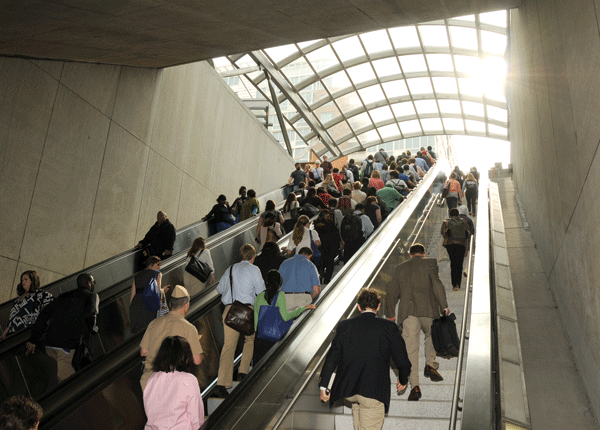 a bill to create the Washington Metropolitan Area Transit Authority (Metro). The interstate Compact was signed by the District of Columbia, the Commonwealth of Virginia, and the State of Maryland. Metro continues to be chartered by this interstate Compact. Among all transit providers in the Washington region – which number more than 15 – Metro is unique in that it serves both states and the District. It provides the only truly regional transit network.
a bill to create the Washington Metropolitan Area Transit Authority (Metro). The interstate Compact was signed by the District of Columbia, the Commonwealth of Virginia, and the State of Maryland. Metro continues to be chartered by this interstate Compact. Among all transit providers in the Washington region – which number more than 15 – Metro is unique in that it serves both states and the District. It provides the only truly regional transit network.
In the late 1970s, Metro trains carried just over 100,000 passengers a day and served hundreds of thousands of passengers on the bus system. Since then, most rail stations in the core of the system have seen ridership more than double. As depicted below, rail average weekday ridership system-wide has gone from just over 500,000 in 1990 to almost 750,000 today, or 220 million trips annually, while weekday bus ridership has stayed at a stable level of roughly 450,000 daily trips, or 134 million trips annually. Read more…
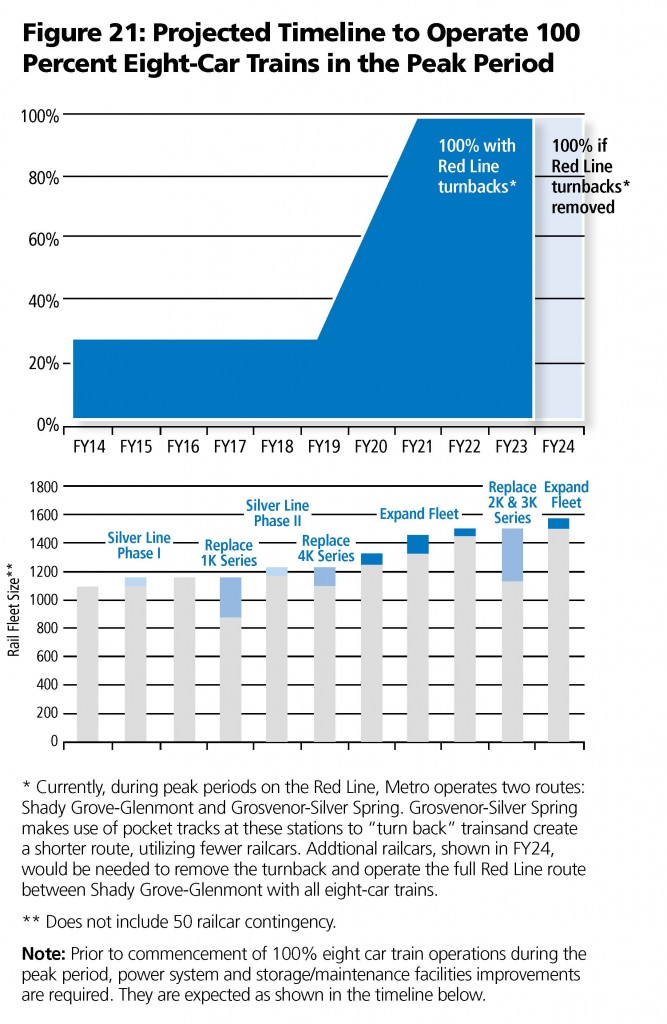
Operating the longest trains possible during the peak periods will maximize the capacity of the existing Metrorail system by enabling operations of 100 percent eight-car trains. Metro will upgrade, replace or expand:
- The rail car fleet
- Traction power substations
- Power cabling
- Third rail
- Train control systems
- Storage tracks and maintenance bays in the yards
Purpose and Need
The Metro system’s core is the destination or transfer point for 80 percent of all rail riders system-wide. Crowded conditions during peak periods exist currently and, without rail fleet expansion, most rail lines will be even more congested by 2025. Operating 100 percent eight-car trains during peak periods and increasing the capacity of transfer stations (under a related initiative) will provide adequate capacity through 2025.
The strategic plan for Metro supports the vision of tomorrow’s transit ride and gives guidance to the types of investments and decisions that Metro can and must make in order to achieve this vision and support the region. The strategies flow directly from Metro’s Board-endorsed vision, mission, and goal statements, and provide the overarching framework for executing the General Manager’s business plan.
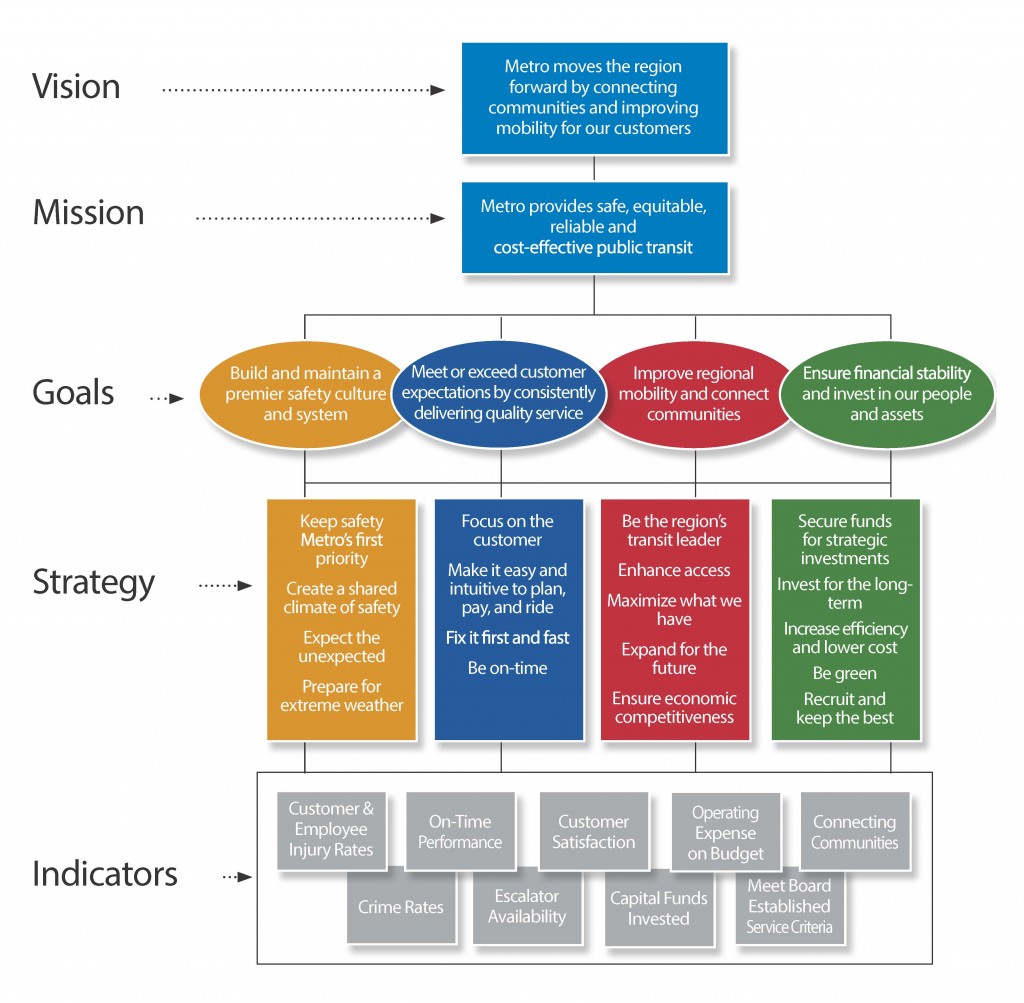
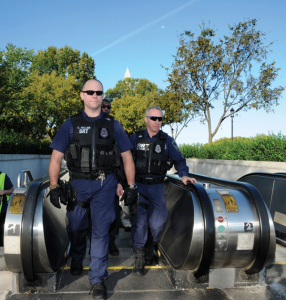 Metro’s Board took the lead in building a safety-first culture by establishing the Safety and Security Committee. Metro has also adopted an analytical approach to prevent incidents by employing smart technology and identifying hazards early. All of Metro’s efforts to improve safety since 2010, including increased communication and analysis, have been recognized by the Federal Transit Administration (FTA) and the National Transportation Safety Board (NTSB).
Metro’s Board took the lead in building a safety-first culture by establishing the Safety and Security Committee. Metro has also adopted an analytical approach to prevent incidents by employing smart technology and identifying hazards early. All of Metro’s efforts to improve safety since 2010, including increased communication and analysis, have been recognized by the Federal Transit Administration (FTA) and the National Transportation Safety Board (NTSB).
The actions over the last two years include:
- Deploying safety officers and Metro Transit Police geographically based on hazard reporting, analysis of crime statistics and identified “hot spots”;
- Installing hundreds of security cameras and video technology on buses, to decrease the occurrence of incidents and improve alertness;
- Closing all ten recommendations of the FTA’s State Safety Oversight Audit;
- Completing six internal safety audits, making Metro current with the three-year cycle required by the System Safety Program Plan;
- Continuing to develop the confidential close-call reporting system;
- Developing a Fatigue Risk Management System, a Fatigue Executive Steering Committee, and hours of service maximums to effectively address fatigue throughout the Authority; and
- Closing seven NTSB recommendations, submitting fourteen for closure, and continuing progress on six.
Read more…











Recent Comments